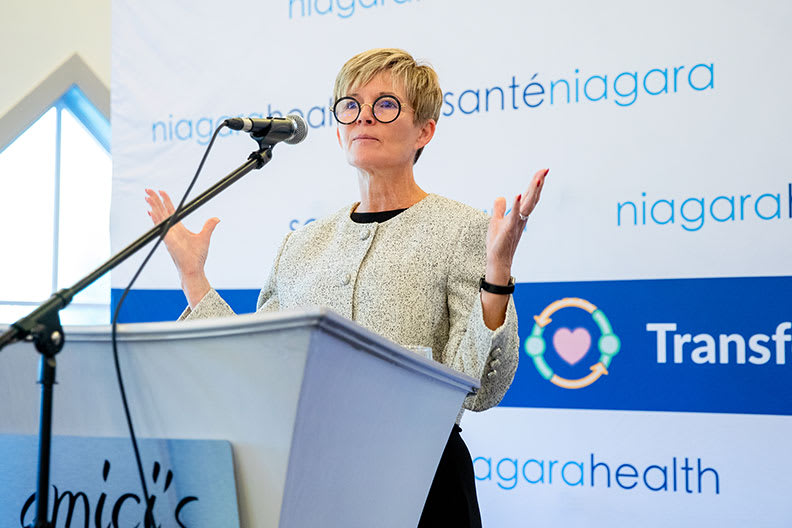
Today, Niagara Health shared a candid update on its five-year strategic plan, Transforming Care, outlining the progress made since its launch in 2023, the challenges facing hospital care in the region and the focus moving forward as the hospital system prepares for the opening of the new South Niagara Hospital in 2028.
“Every decision, every investment, every change is about the care a person receives when they come through our doors,” says Niagara Health President and CEO Lynn Guerriero. “This plan has always been about putting people first — our patients and our team members — and ensuring Niagara has the hospital system it deserves.”Challenges facing Niagara Health
Hospitals across Ontario continue to face major pressures, and Niagara is no exception. Recruitment and retention remain difficult, with national and provincial shortages of staff and physicians. Aging demographics, rising demand for complex care and long Emergency Department (ED) wait times are adding to the strain. Niagara also continues to face a shortage of more than 90 family physicians, leaving Emergency Departments as the safety net for primary care gaps.
Progress to date
Despite the pressures, Niagara Health reported important progress:
- Recruitment and retention: Niagara Health has one of the lowest nursing vacancy rates in Ontario at just 2.4 percent, and vacancies have been reduced by 43 percent since 2022. More than 3,400 roles have been filled through enhanced recruitment. Over the past year, Niagara Health has welcomed new physicians and surgeons across a range of specialties, including four anesthesiologists, three emergency physicians, two general surgeons, one geriatrician, eight internists, one hospitalist in neurology, two hospitalists, two in mental health and addictions, one orthopedic surgeon, one plastic surgeon, one respirologist, one intensivist and one pediatrician.
- Emergency care improvements: Niagara Health has strengthened ED care teams by adding ED technicians, PSWs and porters. ED technicians are trained paramedics who work alongside nurses to support assessments, monitoring and care for stable patients, helping reduce offload delays and improve flow. Niagara Health has also introduced an ED Ambassador program at the Marotta Family Hospital to improve safety and communication in waiting areas, ensuring patients and families are supported and the sickest patients are identified faster.
- Diagnostics and research: With donor support through the Niagara Health Foundation, Niagara Health became the first hospital system in Canada to install a fleet of next-generation CT scanners, reducing wait times and improving accuracy. Donors also helped bring a new, advanced MRI machine to Niagara Health. The Niagara Health Knowledge Institute continues to expand clinical research and university partnerships, linking knowledge directly to patient care.

Niagara Health President and CEO Lynn Guerriero shares progress on the hospital system's five-year Strategic Plan, Transforming Care, during a midpoint update event on Oct. 9, 2025.
Focus moving forward
Looking ahead, Niagara Health emphasized the next three years will require focused effort in several areas:
- South Niagara Hospital and Welland redevelopment: Construction of the South Niagara Hospital — Canada’s first WELL-certified hospital designed to promote health and wellbeing in every aspect of its design — is now reaching its 11th floor. At the same time, redevelopment of the Welland Hospital will be critical to the success of the future three-site model. Welland is positioned to expand complex care, day surgery and other specialized services, ensuring the site continues to play a vital role in Niagara Health’s system of care. Both projects are central to building a sustainable hospital network that meets long-term needs but local share commitments required by provincial policy are key to moving forward.
- System-wide transformation: Niagara Health is working to integrate its Marotta Family, Niagara Falls and Welland hospitals into one connected system. This means aligning programs and services across sites, reducing duplication and creating more consistent experiences for patients. Defining the unique role of each hospital and coordinating care between them, will improve patient flow, reduce wait times and deliver equitable access regardless of where patients enter the system. The three-site model will ensure “no wrong door” for residents — the right care, at the right time, in the right place.
“Healthcare is never easy work — it takes resilience, skill and compassion,” Guerriero says. “Our teams give that every day. We will keep being open about where we are and where we are going, keep putting patients first, and keep working together to deliver the care Niagara deserves.”
Watch a short video capturing the spirit of our Transforming Care journey.

